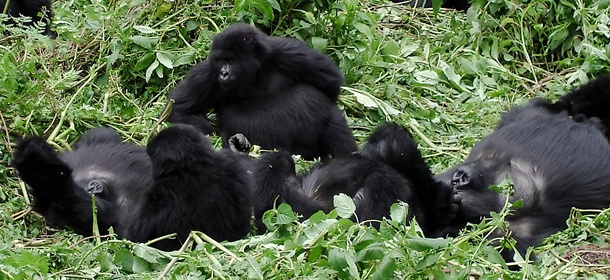 The very rare and endangered Mountain Gorilla can be found in the heavily forested and mountainous areas of Central Africa; chiefly the Democratic Republic of Congo, Rwanda and Uganda. They live in the volcanic mountains of Central Africa in protected national parks. In south-west Uganda they can be found in the Bwindi National Park, in Rwanda in the Volcanoes National Park and in the DRC they live in Virunga National Park.
The very rare and endangered Mountain Gorilla can be found in the heavily forested and mountainous areas of Central Africa; chiefly the Democratic Republic of Congo, Rwanda and Uganda. They live in the volcanic mountains of Central Africa in protected national parks. In south-west Uganda they can be found in the Bwindi National Park, in Rwanda in the Volcanoes National Park and in the DRC they live in Virunga National Park.
The mountain gorilla inhabits the forested slopes of the volcanoes in Central Africa which range in altitude from 7,200–14,100 ft. The volcanoes have created a fantastically lush vegetation which is very dense at the bottom of the mountains, becoming more sparse at higher elevations. It provides the perfect environment for these elusive creatures. The cloud forests where the mountain gorilla lives are often cloudy, misty and cold so they have evolved with thicker fur than their lowland cousins and are classed as a separate sub-species.
Although amazingly strong and muscular the mountain gorilla is actually a very gentle and shy animal. They are herbivores and the vast majority of its diet is made up of leaves, shoots and stems, as well as fruit, bark and insects. They need to eat all day long in order to consume enough calories to survive as they are large muscular animals. A male can eat up to as much as 30 kilos in food a day and this is their predominant activity. The other activities they spend a lot of time doing are sleeping and socialising during their lunchtime rest period. These creatures are wonderfully sociable and they live in secure and stable social groups. They show strong bonds between the male and females gorillas and strong attachment to their young. The lead adult male is the silverback who is the dominant male and he will defend his group above all else. He will eventually be challenged by a younger stronger male and retire to the edges of the group or leave for another one. The gorillas are not territorial and move around areas in search of food.
The mountain gorilla is one of the most endangered animals on the planet. The mountain gorilla (Gorilla beringei beringei) is listed as endangered on the official IUCN Red List which means that it has suffered more than a 50% reduction in population over the last 3 generations. At the last count in the spring of 2010, the estimated total number of mountain gorillas worldwide was just 790. The gorillas of Central Africa suffer from many threats including loss of habitation due to agriculture and logging, pollution, civil unrest and trafficking for the illegal pet trade.
There are many active organisations seeking to conserve the mountain gorillas of Central Africa. Dian Fossey was a leading conservationist who spent most of her adult life in close contact with the gorillas researching them and protecting them. The story of her life can be seen in the film “Gorillas in the Mist”. She and many other conservationists helped to turn these vital cloud forest areas into the protected national parks across the three nations and in doing so preserved their precious and unique habitat. The World Wildlife Fund and the International Gorilla Conservation Programme are the two main leaders in gorilla conservation at the moment
Suprisingly tourism is also fundamental in helping protect this rare species. After land was taken away from local people and turned into protected national parks some kind of recompense was needed to ensure that local people remained in favour of helping the conservation scheme. Limited tourism to visit the gorillas under strict permit schemes has successfully managed to bring a lot of income into the very poor neighbouring areas. In 2008 roughly 20,000 tourists visited the gorilla populations in Rwanda which is turn raised approximately $8 million in revenue for the parks. The other national parks are also benefiting from large tourism revenue streams which cover the park costs and the wildlife authority in charge of protecting the gorillas. The park rangers that guide the tourists also are able to look after the gorillas as they are in closer contact with them, spotting any snare injuries or other health problems. They can also monitor numbers and hopefully divert any potential threats.